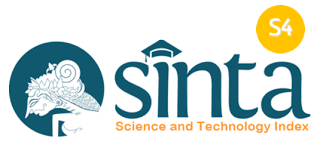Students’ Perception on Learning Grammar through Social Media during Covid-19 Pandemic
Abstract
This study aimed to describe students' perceptions in learning grammar using social media during the Covid-19 pandemic. This research used qualitative method with descriptive analysis. The subjects of this study were 20 students who had been taught grammar through social media due to the Covid-19 pandemic outbreak in the third semester of the English Education Department of the Sultan Amai State Islamic Institute of Gorontalo in the academic year 2020/2021 which were taken with a purpose. Data collection that used was questionnaires and interviews. The data obtained were analyzed through data reduction, data display, and drawing conclusions / data verification. The results of this study indicated that Students perception show that the most preferred social media for learning grammar by using social media was YouTube, Zoom, and WhatsApp and based on the result of research it showed that learning grammar by using social media are quite diverse and elaborate it. was very helpful, increasing the value, quite flexible but less motivated, less facilitated, not effective, has more disadvantages than advantages and less of interested. Based on students’ perception, 15 out of 20 students feel that they are not facilitated by the network to access the internet to learn grammar online because many students learn in their respective areas which are still difficult to signal to access the internet.
Keywords: Grammar Learning, Social Media, Students’ Perception
Full Text:
PDFReferences
Adimawati Helingo. (2020). Model dan Media Pembelajaran Bahasa Berbasis Online dan Offline.
Baleghizadeh, S., & Oladrostam, E. (2011). Teaching Grammar for Active Use: a Framework for Comparison of Three Instructional Techniques. TEFLIN Journal, 22(1).
Barron, A. B., Hebets, E. A., Cleland, T. A., Fitzpatrick, C. L., Hauber, M. E., & Stevens, J. R. (2015). Embracing multiple definitions of learning. In Trends in Neurosciences. https://doi.org/10.1016/j.tins.2015.04.008
Bikowski, D. (2018). Technology for Teaching Grammar. In The TESOL Encyclopedia of English Language Teaching (pp. 1–7). John Wiley & Sons, Inc. https://doi.org/10.1002/9781118784235.eelt0441
Bilfaqih, Y., & Qomarudin, M. N. (2015). Esensi Pengembangan Pembelajaran Daring. In Deepublish (Vol. 1, Issue 1). http://digilib.esaunggul.ac.id/public/UEU-Journal-3642-ari pambudi.pdf
Chapelle, C. A., & Sauro, S. (2017). Introduction to the Handbook of Technology and Second Language Teaching and Learning . In The Handbook of Technology and Second Language Teaching and Learning. https://doi.org/10.1002/9781118914069.ch1
Hoi, S. C. H., Sahoo, D., Lu, J., & Zhao, P. (2021). Online learning: A comprehensive survey. Neurocomputing. https://doi.org/10.1016/j.neucom.2021.04.112
Hopp, H. (2022). Second Language Sentence Processing. In Annual Review of Linguistics. https://doi.org/10.1146/annurev-linguistics-030821-054113
Knapp, P., & Watkins, M. (2005). Genre, text, grammar: Technologies for teaching and assessing writing. Education, 17(2), 258. http://books.google.com/books?hl=en&lr=&id=6VP1slspP7oC&oi=fnd&pg=PA6&dq=Genre,+text,+grammar:+technologies+for+teaching+and+assessing+writing&ots=5qvlMB4nLn&sig=6NCFbL6kwv6gGhXOqWSi1Em_384
Kokoç, M. (2019). Flexibility in e-Learning: Modelling Its Relation to Behavioural Engagement and Academic Performance. In Themes in eLearning.
La Hanisi, A., Risdiany, R., Dwi Utami, Y., & Sulisworo, D. (2018). The use of WhatsApp in collaborative learning to improve English teaching and learning process. International Journal of Research Studies in Educational Technology. https://doi.org/10.5861/ijrset.2018.3004
Valdeón, R. A. (2021). Perspectives on interpreting. In Perspectives: Studies in Translation Theory and Practice. https://doi.org/10.1080/0907676X.2021.1922130
Yodha, S., Abidin, Z., & Adi, E. (2019). PERSEPSI MAHASISWA TERHADAP PELAKSANAAN E-LEARNING DALAM MATA KULIAH MANAJEMEN SISTEM INFORMASI MAHASISWA JURUSAN TEKNOLOGI PENDIDIKAN UNIVERSITAS NEGERI MALANG. Jurnal Kajian Teknologi Pendidikan. https://doi.org/10.17977/um038v2i32019p181
DOI: http://dx.doi.org/10.30984/jeltis.v3i1.2431
Article Metrics
Abstract view : 658 timesPDF - 355 times
Refbacks
- There are currently no refbacks.






